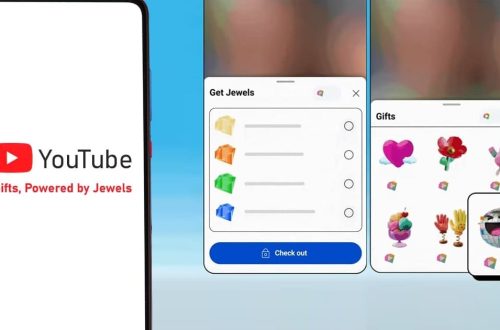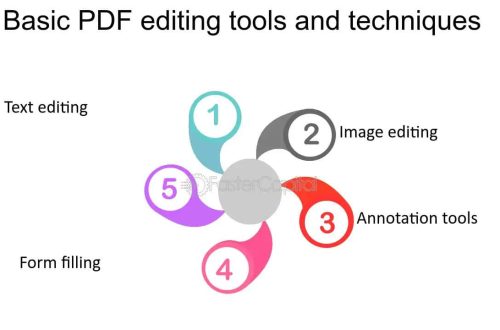Are you on the lookout for examples of business blogs to inspire your next venture?
You’re in luck because in this post, we’ve listed the best examples of business blogs from around the web.
We chose blogs with high and low amounts of traffic for variety.
You’ll also find a breakdown of each blog’s approach to content, revenue, and social media.
Before we get started, here’s a brief roundup of the tools we used to uncover the metrics you’ll find below:
- Moz – Domain authority (DA).
- Similarweb – Traffic, specifically the average number of visits over a three-month period.
- Pingdom – Load time.
- Wappalyzer – Content management system (CMS).
Let’s get into it.
The best business blog examples
- The Balance – A popular personal finance blog that also covers topics related to small business.
- Business News Daily – Tips and trends on entrepreneurship and small business. It’s run by a team of professional writers with extensive experience in the editorial industry.
- Upflip – A great resource on learning about a variety of different side hustles, including starting a vending machine business and even a cleaning company.
- Side Hustle Nation – The blog of experienced entrepreneur Nick Loper, who shares tips on how to start a business on the side of your daily life.
- Startups. – A fantastic resource for startups and small businesses in the UK. It’s full of tips on getting started and managing just about every aspect of business.
- Gigworker – The blog of Brett Helling, who’s driven for Uber, Lyft and Postmates extensively. He shares tips on working a variety of different side hustles.
- Both Sides of the Table – The blog of Mark Suster. Mark uses the blog to share his experience as being an entrepreneur and now a venture capitalist.
1. The Balance
DA: 70 | Traffic: 10.3 million visits per month | Load Time: 494ms | CMS: N/A
The Balance is one of the biggest personal finance blogs on the web.
It’s part of the Dotdash Meredith publishing family, which also owns People, Investopedia, Better Homes & Gardens, Byrdie, Serious Eats, AllRecipes, Southern Living, and more.
While they cover a lot of topics related to personal finance, including banking, mortgages, investing and budgeting, they also cover topics related to small business.
The blog’s team features a handful of senior editors and managers who are in charge of specific areas of focus.
They also work with a financial review board filled with about a dozen financial experts and professionals who ensure the blog’s content is accurate and up to date with current financial practices.
Over the last 20+ years, the blog has published over 14,000 articles on finance-based topics.
Content
Like we said, The Balance publishes content on all topics related to personal finance, specifically under such categories as Budgeting, Investing, Mortgages, Economics and Banking.
However, we’re going to focus on the content they publish to a category called Small Business.

The blog’s content under this category is well represented by the child categories they’ve created for it: Operations & Success, Office Setup, Business Tools, Business Insurance, Entrepreneurship, Becoming an Owner, Business Banking, Business Taxes, and Business Financing.
You can filter the view of the Small Business archive page by specific business-related tags, including Crowdfunding, Unlimited Liability, Seed Capital, Net 30 and more.
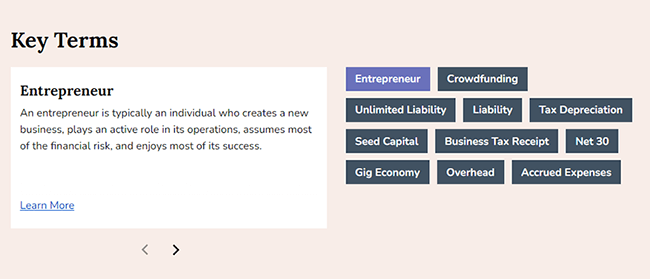
A handful of writers publish content to this category, which keeps the blog up to date with fresh content.
The Balance publishes short to medium-form content to the Small Business category with little to no images published in each post, except for the post’s featured image.

Income streams
The Balance uses several ads on blog post pages, no matter how short they are.
There’s a floating ad at the top of the page that sometimes takes up a good portion of the screen until you scroll down a little.
There’s also a large ad at the bottom of every post as well as quite a few ads in the sidebar depending on how long the post is.

One post had eight ads here.
The Balance also accepts sponsorship deals and offers dedicated ad spots, which helps them promote ads that align with the interests of blog readers.
The blog also receives affiliate commissions for credit cards and other financial products they recommend.
Social media activity
The blog has accounts for Facebook, Instagram, Twitter and TikTok, but activity is sparse across the board.
Nevertheless, they don’t receive very many engagements on any social media channel.
2. Business News Daily
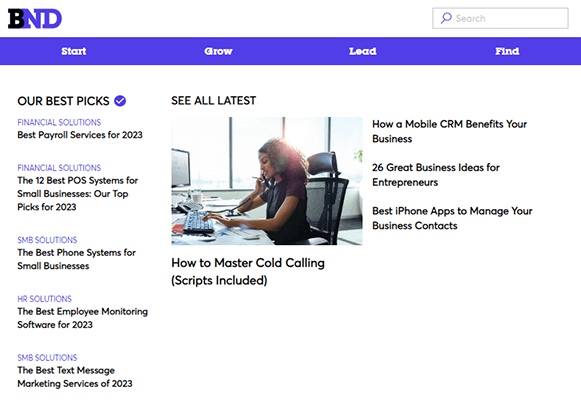
DA: 76 | Traffic: 2.7 million visits per month | Load Time: 461ms | CMS: N/A
Business News Daily is a blog that’s operated as a professional digital editorial publication.
It’s run by a team of experienced writers who have backgrounds writing for ABC News Digital and Top Ten Reviews.
Other team members have extensive experience in the world of business. Titles include Editor in Chief, Editor, B2B Writer and Product Manager.
The site is part of a family of brands that includes Business.com and BuyerZone.
With Business News Daily, the company publishes guides and tips on small business and entrepreneurship as well as guides on the latest trends in small business.
Content

Business News Daily’s content is divided into four main categories:
- Start – Business Ideas, Business Plans, Startup Basics, Startup Funding, etc.
- Grow – Sales & Marketing, Finances, Your Team, Technology, etc.
- Lead – Leadership, Women in Business, Managing, Strategy, etc.
- Find – HR Solutions, Financial Solutions, Marketing Solutions, Security Solutions, etc.
This list sums up the majority of the blog’s content as well as a lot of the blog’s child categories.
They publish everything from guides and product reviews to list posts on various subjects.
Content is written by a handful of writers, which allows the blog to publish several articles a week.
Even with this busy publication schedule, the blog still manages to publish medium to long-form posts that are well researched and highly informative.
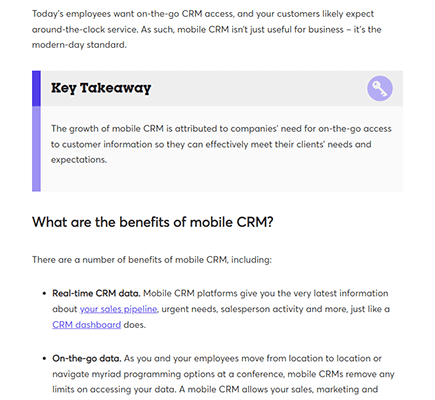
However, most posts have no images, other than a featured image at the top of the page.
Income streams
Advertising is a primary source of income for Business News Daily.
Their advertising elements are powered by Business.com, who accepts advertising deals from brands.
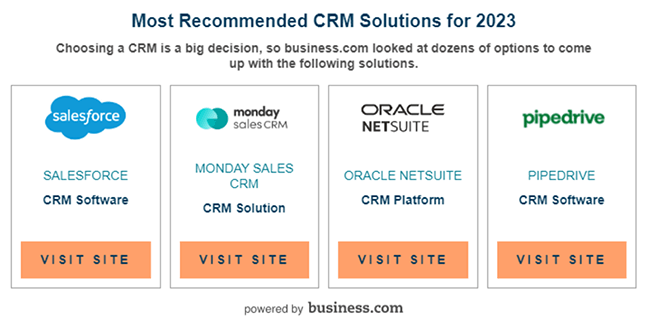
This means you can be sure the ads you see on this blog are for business-related brands.
They also use affiliate links for products they review and recommend.
Social media activity
Business News Daily has social media accounts for Facebook, LinkedIn, Twitter and Pinterest, but they don’t post to them often.
They also have a low number of engagements across all platforms.
3. UpFlip

DA: 32 | Traffic: 669,100 visits per month | Load Time: 1.7s | CMS: WordPress
UpFlip is a blog and online education portal dedicated to entrepreneurship.
It’s run by three relatable founders: Christopher Mondragon of Queen Bee Cleaning, Adam Hill of Hill Vending and Brandon Vaughn of Wise Coatings.
Their blog covers a wide range of business-related topics, and they even delve into online courses.
They also have a podcast and an active YouTube channel.
Content
Let’s talk about the company’s blog content.

UpFlip does not use categories on the frontend of their site, so the only ways to find content is through browsing the Blog page or using the search widget in the sidebar.
While they may very well have categories they use internally, it’s not recommended for most blogs, especially new blogs, to publish posts to a single category.
It’s a sign that your niche is too broad, which means you haven’t chosen a target audience and you cover too many topics.
This certainly does seem to be the case with UpFlip and could be why they have such a low domain authority score, even if they receive a decent amount of traffic every month.
In fact, according to SimilarWeb’s data, 36.9% of their traffic is direct while only 52.26% is organic.
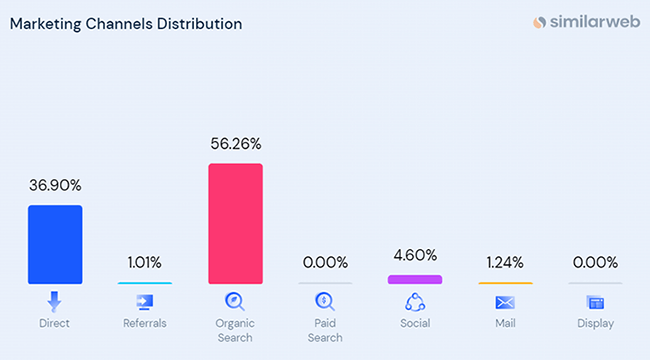
If we use a site with a high domain authority score, such as Business News Daily, to compare, we can see what defining your niche does to your traffic distribution.
82.13% of Business News Daily’s traffic is organic while only 15.84% is direct. Their domain authority is 76.
When you look at UpFlip’s blog archive, you can see that while most of their content is related to entrepreneurship and starting your own business, they don’t seem to pick one area of entrepreneurship or a specific type of business to focus on.
This is something to think about when you start your own blog.
At the same time, this could also be part of the realities of having a successful YouTube channel and a not-as-successful blog.
As far as the posts go themselves, UpFlip publishes well-written, long-form posts with a lot of images.
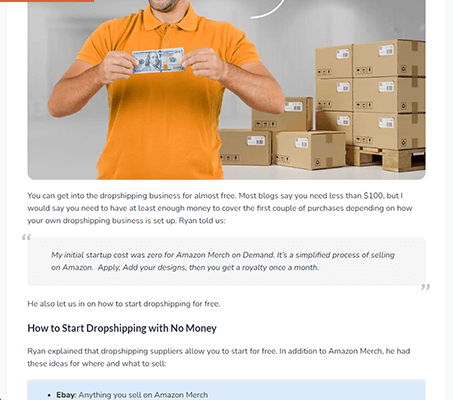
Income streams
UpFlip uses ads on blog post pages: one that sticks to the bottom of the browser’s viewport, one that floats in the right-hand sidebar and a few scattered in the post’s body.
According to technologies detected by Wappalyzer, the blog uses AdThrive, PubMatic, TripleLift, GumGum and Amazon Advertising.
They also use cloaked affiliate links for products they recommend.
UpFlip also has online courses with prices starting at $797 per course.
They also receive sponsorships, especially on their YouTube channel.
Social media activity
Let’s start with the brand’s YouTube channel, which has more than 747,000 subscribers and over 63 million video views from just over 150 videos.
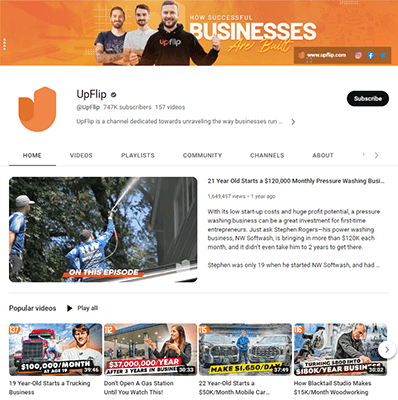
Each video is an entire episode dedicated to sharing success stories from real-life entrepreneurs who started from humble beginnings.
The brand also has an active podcast series where they interview fellow entrepreneurs.
Other than that, they’re on Facebook, Instagram and Twitter, but they don’t receive many engagements on any of these accounts.
4. Side Hustle Nation

DA: 57 | Traffic: 613,000 visits per month | Load Time: 600ms | CMS: WordPress
Side Hustle Nation is the blog of entrepreneur Nick Loper, who hosts the ever popular podcast The Side Hustle Show, which has 4.7 stars out of over 1,400 ratings on Apple Podcasts.
Nick uses the blog as a hub for articles related to starting businesses as side hustles without burning yourself out.
He started out as an entrepreneur himself by starting a business on the side while working fulltime for Ford fresh out of college. He worked nights and weekends on his side hustle to pull it off.
Now, he’s an entrepreneur for a few different projects and has been featured by The New York Times, NBC, Fortune, TED and Entrepreneur.
Content
Side Hustle Nation focuses on a few different types of side hustles related to online business, freelancing, ecommerce and investing.
In fact, these are the blog’s primary categories.

Most articles they publish are related to one of these categories.
They publish several articles every week.
Articles are written in long-form format with several images accompanying each one.
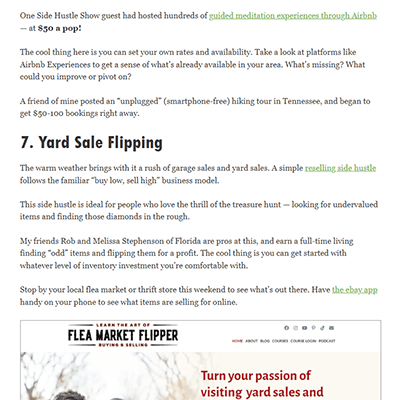
They also accept guest authors.
Income streams
Side Hustle Nation accepts sponsorships for its podcast and newsletter.
They also use affiliate links and accept affiliate sponsorships.
Nick also has 12 books that he sells on Amazon, one of which, The Side Hustle: How to Turn Your Spare Time into $1000 a Month or More, has a 4-star rating out of over 1,700 reviews.
Social media activity
Side Hustle Nation doesn’t really use social media like most blogs do.
Their primary channel is a private Facebook group, which has more than 55,000 members.
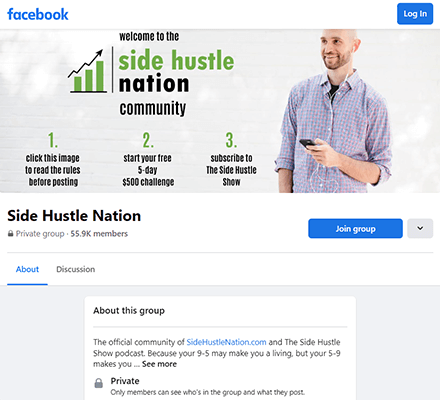
It receives about five posts a day and over 100 posts per month.
Nick uses his own LinkedIn and Twitter accounts to promote the blog, but neither receive many engagements.
5. Startups.

DA: 70 | Traffic: 323,600 visits per month | Load Time: 484ms | CMS: WordPress
Startups is a UK-based blog that’s all about helping small businesses in the UK launch, grow and thrive.
It was founded in the year 2000 and is currently operated by a managing editor, content manager, senior writer and a few additional writers.
Their content covers everything you need no matter where your business is at, but especially if you haven’t started it or it’s still in the beginning stages.
Content
Startups covers a lot of content related to planning, launching and managing a small business.
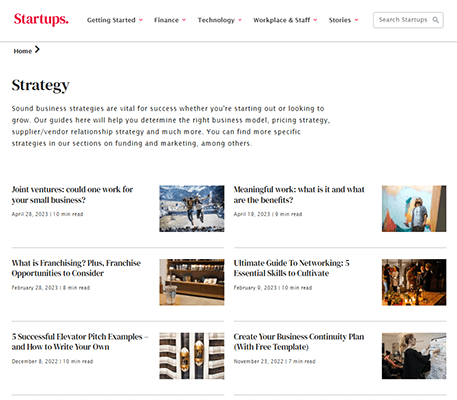
However, the site’s content is well represented by the menu items found within their primary navigation menu:
- Getting Started – Planning your business, building your website and marketing your business.
- Finance – Funding your startup and managing cashflow.
- Technology – Key software your business needs, managing communication among management staff and team members. Plus, vehicle tech.
- Workplace & Staff – Building and maintaining the workplace, plus handling the hiring and managerial aspects of business.
- Stories – Reports and profiles for real entrepreneurs and startups.
The blog’s homepage also has dedicated spots for their latest articles, most popular articles, trending topics, and articles that fall under the following umbrellas: Essential Guides, Templates & Tutorials, and How to Start.

The blog covers a lot of news, so new posts are published on a daily basis, sometimes twice a day.
News posts are short while all other content is written in medium and long-form formats.
Most articles have little to no images.

Income streams
Affiliate marketing is a primary source of income for Startups.
They use affiliate links and affiliate-based calls to action in blog posts.
They also offer advanced advertising through the customer generation service MVF Global.
Social media activity
Startups is active on Facebook, Twitter and LinkedIn, but they only receive a dozen or so likes per post on each platform.
6. Gigworker

DA: 56 | Traffic: 298,900 visits per month | Load Time: 1.21s | CMS: WordPress
Gigworker is a blog full of tips on working a variety of different side hustles, including rideshare driver, Airbnb host, freelance anything and more.
It’s owned by Brett Helling who has experience completing hundreds of trips for companies like Uber, Lyft and Postmates.
It’s this experience that led to him acquiring Ridester, a blog specifically dedicated to publishing tips and insights on rideshare driving.
He’s even been quoted by Forbes, CNBC, Vice and more.
Gigworker itself has been featured on Inc., Business.com, Vox, The Fast Company and Forbes.
Content
Gigworker’s content focuses on the following primary categories: App-Based Gigs, Freelancing and Small Business.
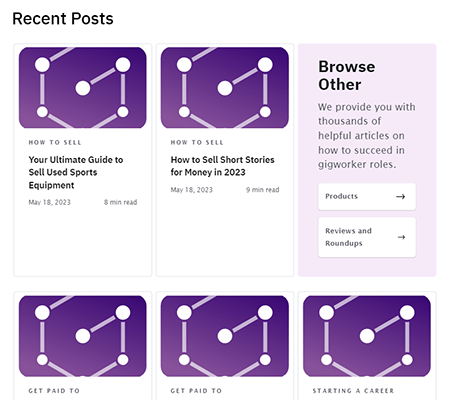
The App-Based Gigs category includes advice on working for apps like Uber, DoorDash, Wag, Airbnb and more.
The Freelance category covers all topics related to getting started with freelancing and finding your first clients.
The Small Business category is quite extensive for a site dedicated to the gig economy.
Topics range from starting a business and digital marketing to managing finances and dealing legal, insurance and tax issues.
The blog receives several updates every week, and all articles are published under Brett’s name.
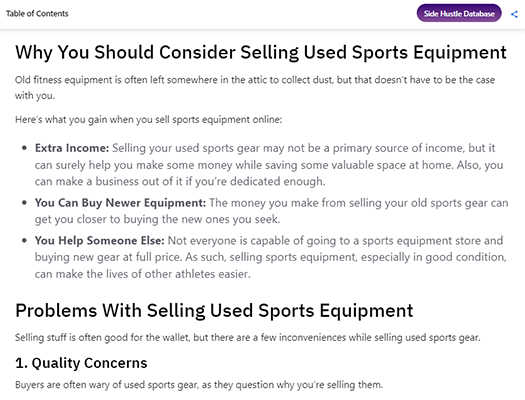
He publishes medium to long-form posts but hardly uses images, if any.
Income streams
Gigworker uses ads from a variety of different ad solutions, primarily Mediavine, GumGum, TripleLift, PubMatic and Amazon.
One ad sticks to the bottom of the browser’s viewport while the rest are inserted throughout the body of every blog post.
Affiliate marketing is also a primary source of income for the blog, especially in list posts.
The site also has a paid job board in which companies looking for temporary or contract workers are able to publish listings.
Brett has also published a book on the gig economy.
Social media activity
Gigworker is not active on social media.
7. Both Sides of the Table

DA: 63 | Traffic: 34,300 visits per month | Load Time: 876 | CMS: Medium
Both Sides of the Table is the blog of Mark Suster, a “2x entrepreneur” who is now a venture capitalist of Upfront Ventures, a Los Angeles-based venture capital firm.
Mark was a software developer for Accenture before he became the founder and CEO of two successful enterprise software companies.
After he sold one of his companies to Salesforce, he joined Upfront Ventures as a partner and now focuses on providing funding for up and coming SaaS companies.
As the name suggests, Both Sides of the Table provides insights, opinions and recommendations from the perspective of an entrepreneur who has received funding and a venture capitalist who has granted it.
Additional editors for the blog include Kerry Bennett, the Head of Marketing at Upfront Ventures, and Kyle Taylor, the Product Manager for Upfront Ventures.
Content
The blog, while not as active as the other blogs on this list, covers a variety of different topics related to entrepreneurship and venture capital funding.
Its primary categories, which Medium calls “tags,” are Entrepreneurship, Startup Lessons and Venture Capital.
It also has a tag for Upfront, which features news related to the firm.
Unfortunately, the blog doesn’t always use Medium’s tag feature, so you’re better off finding content by browsing the blog’s archives.
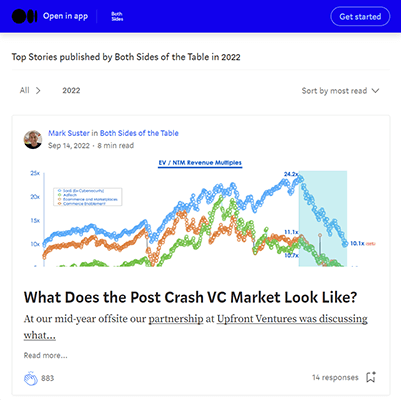
Almost every blog article is written by Mark.
Most articles are written in long-form format and include plenty of images, especially posts that cite a lot of statistics.

Income stream
Both Sides of the Table doesn’t seem to use any income streams, even though Medium does have a partner program as well as the ability to offer paid subscriptions for premium content.
Instead, the blog seems to be a bit of a casual content marketing strategy to aid Mark’s long-term partnership with Upfront Ventures.
Social media activity
The social media accounts linked to Both Sides of the Table are Mark’s Twitter account, which receives a dozen likes per post, and Mark’s personal Facebook account.
Final thoughts
Let’s talk about a few key takeaways from this list.
The first is how domain authority doesn’t always correlate with traffic.
A low-traffic site can have a high domain authority while a high-traffic site can have a low-domain authority.
This is in contrast to what you’d normally expect: a low-traffic site having a low domain authority and a high-traffic site having a high domain authority.
It’s all about how many backlinks your site has and how many articles you have on the first page of Google.
In short, the higher you appear in search engines for your target keywords, the better.
As a new blog, the best thing you can do to establish authority is really hone in on your niche and publish stellar content for keywords related to it.
Here are a few articles to get you started:
The other big takeaway we’ll mention is how little social media seems to affect a blog’s performance.
This is something we’ve noticed in almost every one of our articles on the best blog examples, such as travel blog examples, lifestyle blog examples and music blog examples.
Blogs who receive hundreds of thousands and even millions of visits receive very little engagements across all social media channels.
So, while very few sites need an active following on social media to get ahead in the world of blogging, you may discover a gap your competitors are leaving on key platforms.
Here are a couple minor takeaways.
The first has to do with the way you write your posts.
While the big blogs on this list can get away with publishing short posts, you’re going to need to work a little harder than that to catch up.
Also, a lot of these blogs aren’t doing themselves a favor in the authority department by not adding images to their posts.
Be sure to add a few images to yours.
Lastly, ads and affiliate links seem to be among the best ways to monetize this type of blog, but courses and books are great as well.




